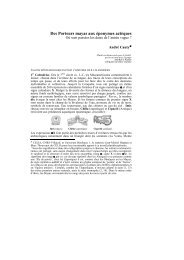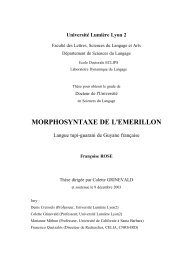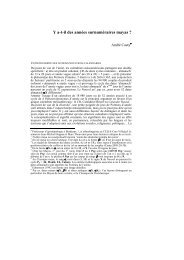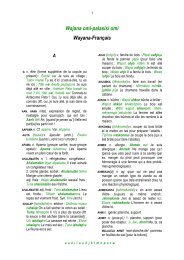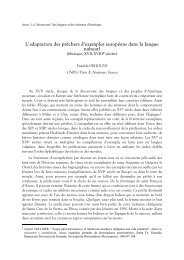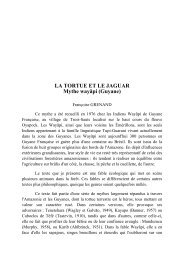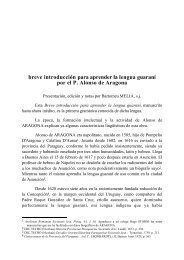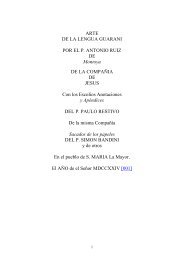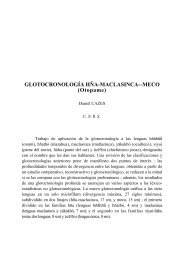The Blue Bird of Ergativity - celia
The Blue Bird of Ergativity - celia
The Blue Bird of Ergativity - celia
You also want an ePaper? Increase the reach of your titles
YUMPU automatically turns print PDFs into web optimized ePapers that Google loves.
he-LOC pen a want-IMPF'He needs/wants a pen.'So ergative marking does not affect all A arguments, by Dixon's definition.Nor, as we have seen, does it affect only A arguments. Thus, it does not selectDixon's A as a class, and no other rule or pattern in the language does either. Butproblems with the A category are old news. More striking is the fact that, inTibetan, there is no emic object, or O, category -- that is, there is no rule whichaffects, or construction which involves, or however you want to put it, all and onlyO arguments. Most dramatically, as we have seen, O arguments are differentiallymarked according to the type <strong>of</strong> verb. That is, Tibetan provides exactly the samekind <strong>of</strong> evidence for distinguishing <strong>The</strong>me and Goal objects as Dyirbal does fordistinguishing A and S.What this means is that it is entirely possible to write a complete,comprehensive grammatical description <strong>of</strong> Tibetan and never mention the A or Ocategory. In fact, this is objectively the best way to describe the language; anyreference to an O or object category will only be for the purpose <strong>of</strong> making the facts<strong>of</strong> the language accessible to someone who is used to thinking in those terms. And,even if one should want to mention a category <strong>of</strong> transitive subject, or A, orsomething, that category does not correspond to Dixon's A, since it excludes some(but not all) experiencer subject clauses. And, since some intransitive arguments arezero-marked, others ergative marked, and a few dative-marked, there is nogrammatically distinct S category in the language. <strong>The</strong>se terms remain descriptivelyuseful only because they provide a terminology for laying out these facts in amanner that will be accessible to someone who is used to thinking in terms <strong>of</strong>subject and object, but they have no reality whatever within the language itself.What can we believe in??<strong>The</strong> term ergative has a well-established and necessary place in linguistics,as the name for a surface case category. Many languages have a case form whichoccurs only or primarily with the subject-like argument <strong>of</strong> a transitive clause, and indescribing such a language we need to call it something. It is also <strong>of</strong>ten useful torefer to ergative constructions, in languages where these contrast with nominativeconstructions. But the word ergativity implies something more, that languages withsuch a case form (or, perhaps, where such a case form occurs in the discoursepragmaticallyleast marked transitive clause pattern) have something more incommon. I do not see that there is very much evidence for any such thing. I thinkthat there is what we might call "nominativity", except that there are better ways to17



